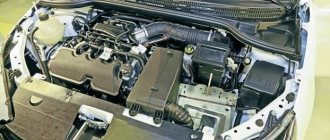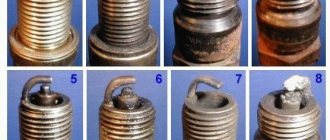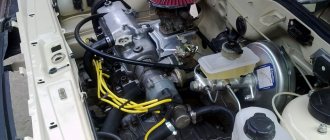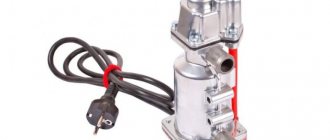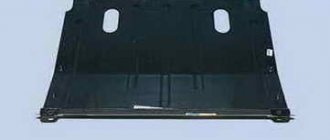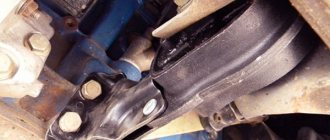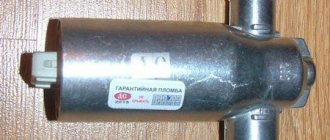This question is not often, but consistently asked by my readers and channel viewers - what is better than 8 or 16 valves in the engine block head? Many people believe that the 8-valve version is a thing of the past and spending your hard-earned money on it is, at the very least, stupid! But 16 is YES, IT IS! Others, on the contrary, insist that the 16 valve version is more expensive, more demanding to maintain, and if it breaks, “write it down”! But where is the truth, and what exactly is the difference between these two units, are they very different? I propose to weigh all the pros and cons, so there will be a video version...
You know, there are really a lot of battles on the Internet on this never-ending topic, but I think everyone here is right in their own way. After all, some expect reliability and simplicity, while others expect greater power and smooth operation. The tasks are different, and the engines are different, but let's take a closer look.
About the technical component
Technically, engines with 8 and 16 valves are quite different. Although all the difference is stored at the top (engine block head) where the car's camshafts (camshaft) are/are installed. In fact, this is the main design feature, but what I want to note is that almost every engine can be made into either an 8 or 16 valve version. For example, on our VAZs, the engines are very similar, and hypothetically, on the same block, you can fit a different cylinder head, with one or two camshafts.
Main differences.
The 8-valve engine has a narrow cylinder head because it has a single camshaft. The candles are located on the block horizontally and at a certain angle. The camshaft controls the order of their opening - first it opens the intake, then the exhaust. The valve opens with the help of conical parts located on the camshaft, and closes with the help of springs located on it. In a four-cylinder engine, there are two valves for each cylinder of the engine - intake and exhaust. Actually, that’s why there are eight of them per power unit.
In a 16-valve engine, the cylinder head is wide in relation to the single-row four-cylinder block, since there are two camshafts on it. The design itself is complicated; the valves are adjusted using hydraulic compensators. Opening and closing have the same principle as in an 8-valve engine. The spark plugs in such engines are positioned strictly vertically, as if buried in the cylinder block cover. For each one engine cylinder there are already 4 valves - which means, respectively, 16 per engine. What if, instead of two small valves, we insert two larger valves... In principle, it is possible, but then the gas will fill the combustion chamber unevenly, and the engine will not operate as silently as we would like.
Advantages of an 8-valve engine:
- Initially, the design of the engine is relatively very simple and, accordingly, easy to maintain.
- The absence of hydraulic compensators undoubtedly simplifies the design of the power plant as a whole.
- Undemanding to oil.
Flaws:
- Power is less compared to a 16 valve engine. It is also impossible to achieve such high speeds - two valves per cylinder does not allow speeding up the intake and release of fuel and gases from the chamber. The process is happening slower than we would like.
- Increased fuel consumption. Due to the fact that the gas exits through one valve, which cannot let through more than it should.
- Such engines are, in essence, noisier, especially when moving at high speeds.
- The absence of hydraulic compensators requires adjustment of the valves as their precise synchronization is disrupted (even with slight deformation of the camshaft cam profile), in the worst case, a knocking sound appears.
16-valve engine and its significant advantages:
- More powerful. It accelerates better and therefore the top speed will be significantly higher than that of an 8-valve engine. More powerful. Accelerates better and therefore the top speed will be significantly higher than the 8-valve engine.
- It is also important that fuel consumption is noticeably less (should be).
- Engine noise is less.
- The valves are regulated by hydraulic compensators.
Flaws:
- The presence of hydraulic compensators requires a timely change of engine oil to avoid coking of the hydraulic compensators.
- Engine maintenance is more expensive. After all, the design of such an engine is an order of magnitude more complex than the design of an 8-valve engine.
A few words about another reason why valves should sit tightly in the seat. In addition to ensuring complete sealing of the combustion chamber, it should be taken into account that the valve discs operate under severe conditions of high heat. In addition, the plates must be in close contact with the seat, which is located on the cylinder head, which is cooled. After all, the heated plate transfers most of the heat to the saddle. This is especially true for the exhaust valve, since it is cooled only through the tight fit of the plate to the seat, and the intake valve is cooled when the incoming air-fuel mixture is in contact with the seat. If there is poor contact with the seat, no (even the most heat-resistant) valve will withstand such strong overheating. It will simply burn out and collapse, so its tight fit in the saddle is very important. Therefore, they are made from heat-resistant metal alloys. In addition, they do not have magnetic properties.
Economical
In terms of fuel consumption, a 16-valve engine differs from an 8-valve engine by being slightly more economical. Multi-valve heads fill and distribute the mixture better due to the versatile filling of the chamber. This design feature ensures economical operation. In addition, fast acceleration allows you to save fuel, which is consumed at high speeds.
In practice, consumption depends on driving style, type of fuel, tire pressure, curb weight and outside temperature.
Despite being economical in terms of fuel consumption, the 16 valve engine requires better oil and gasoline. If in an 8 valve you can get by with semi-synthetics or mineral water, in a 16 valve it is permissible to use only synthetics.
Similar article M103 Mercedes engine
8 valve engine
This is indeed an archaic, but nevertheless reliable, simple and cheap to repair scheme. New cars with such an engine are somewhat cheaper, but are practically not inferior to 16-valve cars either in dynamic characteristics or in fuel consumption. Regular maintenance of such machines is cheaper. Most 8-valve engines have “stickless” pistons, that is, if the timing belt breaks, the piston will not meet the valve. Such engines are not demanding on the quality of motor oil and can easily run on 92-grade gasoline.
The disadvantages include low power; in comparison with a 16-valve engine, it is 10–15% lower. This happens due to the inability to spin the engine more, because the intake and exhaust are slower. 8-valve engines are quite noisy due to mechanical pushers rather than hydraulic compensators, but this is also a plus.
Consumer characteristics
In addition to technical characteristics, when choosing between two types of engines, consumer characteristics are also taken into account.
These include the following aspects:
- operating cost;
- adaptability to tuning;
- service.
Important criteria that are sometimes perceived by buyers as more significant than technical characteristics.
Operating cost
This takes into account not only the price of the engine itself or a car with a certain engine, but also the subsequent operating cost. That is, buyers are interested in how cheap or expensive it will be to operate this or that car.
The concept of operating cost includes the purchase of fuel and all kinds of consumables required as part of the maintenance. Not to be confused with repairs. This issue will be considered separately.
When buying a car, every consumer is obliged to take into account the conditions in which the car will be located most of the time.
In terms of the price of the engine and its operating cost, priority is on the side of the 8-valve power unit. If you buy a car and plan to drive it far from large cities and car repair shops, then you should buy an eight-valve engine. It is cheaper in price, easier to maintain, and less demanding on fuel quality and consumables. Many of these engines can be serviced independently without any problems. It may be inferior in efficiency to its competitor, but sometimes this criterion fades into the background.
The advantages of the 16-valve analogue in the form of power and efficiency imply the manifestation of some disadvantages. For all these advantages you have to pay by having to buy high-quality fuel and good lubricants. The initial price of a car with such an engine will be higher than an 8-valve one.
16 valves are preferable to choose for those who live in a fairly large city, where there are a number of good car services where you can contact if necessary. Such engines are suitable for fans of dynamic and active driving. It is categorically not recommended to save money by purchasing cheap fuel here, since this can lead to serious negative consequences in the form of engine malfunctions.
Repair work
If we talk about the domestic market in Russia and the CIS countries, then here the advantages of 16-valve engines often turn into disadvantages. And the reason is precisely the quality of fuels and lubricants. This applies to a greater extent to fuel, which does not always meet the required standards.
And since 16-valve valves are very sensitive to fuel quality, they often fail and require repair work. Moreover, most problems are associated with clogging of valves and associated elements with impurities from working fluids.
Repairing engines with 16 valves cannot be called simple. To restore them, you need to use sophisticated equipment and some expensive tools. All this negatively affects the increase in the cost of the service. Such engines are equipped with a large number of moving elements. Therefore, the likelihood of failure increases.
Here the advantage is on the side of power units with 8 valves. They are cheaper to repair, fail less often and are better adapted to work even on low-quality fuel.
If the car is purchased for a calm and measured drive in urban conditions, then the capabilities of the 8-valve engine will be fully enough for the driver. This is a time-tested design that almost all car service technicians understand; they require simple and understandable repairs. It is not surprising that engine repairs are sometimes carried out by car owners themselves in their garages.
Fans of active driving and lovers of excellent dynamics are better suited to 16-valve engines. But you'll have to pay more for these features if the power unit fails.
8-valve internal combustion engine
Tuning
Increasingly recently, car owners are thinking about improving and modernizing the standard engine. For these purposes, there are various options for technical tuning, which involve intervention in the design and operation of the power plant.
There is a category of car buyers who do not particularly pay attention to current power and efficiency. They just need a car that they can improve and modify, increase power and change technical characteristics.
When choosing between 16 and 8 valves based on this criterion, the engine with a large number of valves will again be the favorite. Such engines have improved potential for tuning and modernization.
It's all about the distribution of the intake and exhaust tracts in different directions of the cylinder head. This simplifies the installation of exhaust and intake manifolds. Plus, the block head itself is designed for great capabilities, which gives good scope for improvements.
At the same time, it cannot be said that the 8-valve engine has no potential for tuning. Such motors are also subject to modernization, but such work will require more time and effort.
16 valve engine
Such engines are more powerful, more flexible and quieter than their 8-valve counterparts. They allow you to more finely tune the operation of the timing belt, which affects the smoothness of the engine and the environment. It does not require periodic adjustment of the valves, since it is equipped with hydraulic compensators. The advantages also include a wide field for tuning, including installation of a turbine.
This engine also has a lot of disadvantages and, probably, more than the 8-valve engine: expensive repairs, because there are only two; high requirements for the quality of motor oil. It is recommended to use the more expensive 95 gasoline. If we are talking about VAZ engines, then their 16-valve engines traditionally suffer from oil leaks, since their cylinder head consists of three parts.
For the buyer of a new car, a similar choice will arise if he chooses something from AvtoVAZ or Renault. Most brands have not offered alternatives to 16-valve engines for a long time, the reason for this is high environmental requirements. When buying a used car. You can safely buy a car with an 8-valve engine; it is simple, cheap and unpretentious in operation, and also tolerates the transition from gasoline to gas well. Cars with 16-valve engines are more pleasant to drive, but more expensive to maintain.

